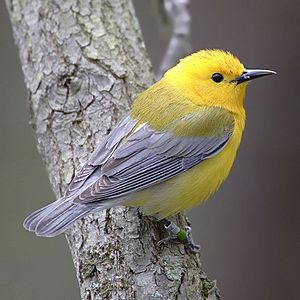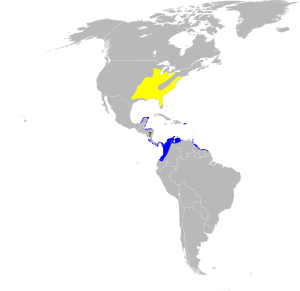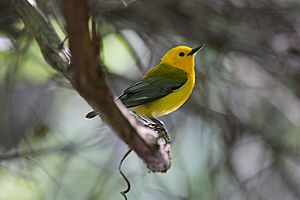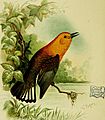Prothonotary warbler facts for kids
Quick facts for kids Prothonotary warbler |
|
|---|---|
 |
|
| Female | |
| Conservation status | |
| Scientific classification | |
| Genus: |
Protonotaria
|
| Species: |
citrea
|
 |
|
| Range of P. citrea Breeding range Wintering range | |
The prothonotary warbler (Protonotaria citrea) is a small songbird of the New World warbler family. It is the only member of the genus Protonotaria.
Contents
Taxonomy
The prothonotary warbler was described by the French polymath Georges-Louis Leclerc, Comte de Buffon in 1779 in his Histoire Naturelle des Oiseaux from a specimen collected in Louisiana. Buffon coined the French name Le figuier protonotaire. The bird was also illustrated in a hand-coloured plate engraved by François-Nicolas Martinet in the Planches Enluminées D'Histoire Naturelle, which was produced under the supervision of Edme-Louis Daubenton to accompany Buffon's text. Neither the plate caption nor Buffon's description included a scientific name but in 1783 the Dutch naturalist Pieter Boddaert coined the binomial name Motacilla citrea in his catalogue of the Planches Enluminées. The prothonotary warbler is now the only species placed in the genus Protonotaria that was introduced in 1858 by the American naturalist Spencer Baird. The species is monotypic, no subspecies are recognised. The genus name is from Late Latin protonotarius, meaning "prothonotary", a notary attached to the Byzantine court who wore golden-yellow robes. The specific citrea is from Latin citreus meaning the colour "citrine". It was once known as the golden swamp warbler.
A molecular phylogenetic study of the family Parulidae published in 2010 found that the prothonotary warbler was a sister species to Swainson's warbler (Limnothlypis swainsonii).
Description
The prothonotary warbler is 13 cm (5.1 in) long, weighs 12.5 g (0.44 oz), and has a wingspan of 22 cm (8.75 in). It has an olive-coloured back with blue-grey wings and tail, yellow underparts, a relatively long pointed bill, and black legs. The adult male has a bright orange-yellow head. Females and immature birds are duller and have a yellow head. In flight from below, the short, wide tail has a distinctive two-toned pattern, white at the base and dark at the tip.
Distribution and habitat
The prothonotary warbler breeds in hardwood swamps in extreme southeastern Ontario and eastern United States. It winters in the West Indies, Central America and northern South America. It is a rare vagrant to western states, most notably California.
Behavior and ecology
The prothonotary warbler is the only eastern warbler that nests in natural or artificial cavities, sometimes using old downy woodpecker holes. The male often builds several incomplete, unused nests in his territory; the female builds the real nest. It lays 3–7 eggs.
The preferred foraging habitat is dense, woody streams, where the prothonotary warbler forages actively in low foliage, mainly for insects and snails.
The song of this bird is a simple, loud, ringing sweet-sweet-sweet-sweet-sweet. The call is a loud, dry chip, like that of a hooded warbler. Its flight call is a loud seeep.
Status
These birds are declining in numbers due to loss of habitat. They are also parasitized by the brown-headed cowbird (Molothrus ater), or outcompeted for nest sites by the house wren (Troglodytes aedon). It is listed as endangered in Canada. The species persists in protected environments such as South Carolina's Francis Beidler Forest, which is currently home to more than 2,000 pairs, the densest known population.
In culture
The prothonotary warbler became known in the 1940s as the bird that, in front of the House Un-American Activities Committee, established a connection between Whittaker Chambers and Alger Hiss. Chambers had testified that Hiss enjoyed bird-watching, and once bragged about seeing a prothonotary warbler. Hiss later testified to the same incident, causing many members to become convinced of the pair's acquaintance.
This bird is mentioned in A Sand County Almanac by Aldo Leopold as the "[J]ewel of my disease-ridden woodlot", "as proof that dead trees are transmuted into living animals, and vice versa. When you doubt the wisdom of this arrangement, take a look at the prothonotary."
John James Audubon's painting of a prothonotary warbler is the third plate in his The Birds of America.
Kurt Vonneguts' novel Jailbird describes the warbler as "the only birds that are housebroken in captivity".
Gallery
-
Painting by John James Audubon
- Prothonotary warbler species account at Neotropical Birds (Cornell Lab of Ornithology)
See also
 In Spanish: Protonotaria citrea para niños
In Spanish: Protonotaria citrea para niños






